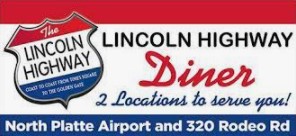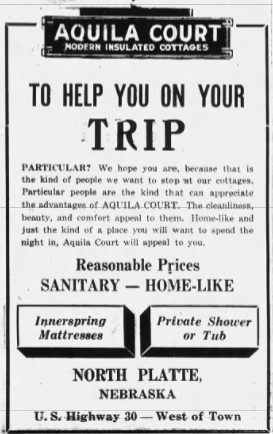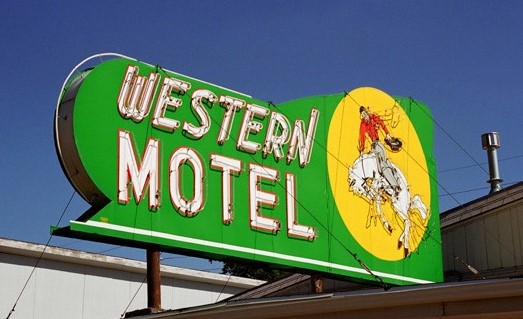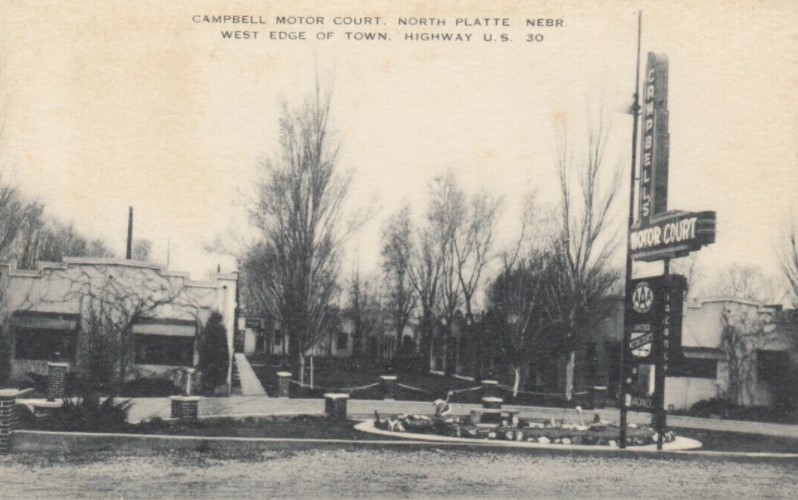Originally published to facebook.com/NorthPlattePL on April 8, 2022.
Last Friday, we took a look at Lincoln Highway/Highway 30 coming through North Platte and Lincoln County. This week, we look at the development of “auto courts” in North Platte along the Lincoln Highway and one unique Nebraskan automotive family, popular in the 1930’s-1950’s. I am guessing this is the one article that many readers have been looking forward to!
Early motorists also had to contend with where to spend the night because the speed limit was 20 miles per hour, meaning that a trip would take several days to make. So travelers would often they pitch tents and cook outdoors; or stay in motor courts or cabins.
For some, this was an economical way to travel; for others it was part of the adventure as Warren Belasco described in “Americans on the Road.” Belasco referred to the early decade of automobile travel (1910-to 1920) as the “gypsy years.” In 1915, Travel magazine ran a series which described the Lincoln Highway from coast to coast. The writer claimed that travelers would find a “superb, swift trail, gleaming before them, the world’s greatest open road,” and that camping could prove to be one of the “chief attractions for travelers on the Lincoln Highway and finally, “camping equipment, cooking utensils and water, become necessary factors, once the tourist leaves Omaha, for the remainder of the journey west.
For those who chose not to camp, existing hotels in cities and larger towns along the route were the only accommodations. New ones soon developed however, such as the “tourist home” which consisted of a room rented in a private residence. Other accommodations included the auto-camp or tourist camp or auto court, which soon developed into the cabin camp. In Nebraska, but about 1930, almost every town on a numbered highway advertised at least one. The term auto-court or motor court or motel are often used interchangeably. The auto-court consisted of a small cabin to stay and secure your belongings and a parking space for your car out front.
By early 1924, the North Platte Chamber of Commerce started receiving requests for auto camps and places to stay. Business people got together and started opening up “auto camps” for tourists. One of the first camps to open was the Chamber Auto Camp Ground, which opened from April 15-Oct 1 of 1924. During this time 4,644 cars parked overnight. The camp had an open building with stoves and sinks with running water; a caretaker; and bathrooms. Although the ended up the year over budget, it was decided to charge 25 cents per night to cover the costs.
Initially an area for pitching tents, these camps soon included a group or row of simple frame, one room cabins. A tourist who stayed at one in Nebraska in the mid-1920’s described it on a postcard, “Dear Mother: This is a sample of the camping grounds we find. Only some places charge fifty cents. We have traveled close to 150 miles so far today… We are so dirty. It has been so warm and dusty. The tiny black flies are as bad as the mosquitoes.”
By 1928, travelers coming through North Platte had plenty of places to get gas and oil, and spend the night. Following the highway through the city, they would pass 19 service stations, the last being on 12th Street (Rodeo Road) and Buffalo Bill Avenue. This equated to approximately 3 miles of gas stations. Most of the downtown stations were located on business corners. All sold gasoline and others sold related business items such as grocery, tires, or campgrounds.
North Platte offered a number of motels on both ends of the city. On the east end, the Black and White Cabin Camp opened in the mid-1930s; each cabin had its own heat, toilet, and shower. On the west end is the nicely kept Cedar Lodge, with Spanish styling and a shaded central courtyard. The Western Motel was once connected to the building next door, when it was the Western Café and Bar-B-Q. Both motels still sport beautiful neon signs. In 1939 WPA guide noted that the town had six hotels and six principal tourist camps, along with rooming houses and smaller camps.
On June 26, 2013, Kaycee Anderson wrote an article “Lincoln Highway jutting through Lincoln County,” highlighting the motels and camps along the Lincoln Highway for the Lincoln Highway Association’s Centennial for the North Platte Bulletin. The rest of this post is taken from Kaycee’s newspaper article:
“…Today, Lincoln Highway signs are prominent in the RV camp at the west end of Rodeo Road where a blues music festival will be held July 19-20, and on a boxing club building on the corner of Rodeo Road and Adams and at the Lincoln Highway Diner at Rodeo Road and Willow. With a closer look, one can still see motels, gas stations and former trading post buildings along Rodeo Road. Some buildings have changed and are hardly recognizable. Many have been torn down.” Here are a few of the motels that were highlighted:
421 W Rodeo Road: Cedar Lodge
Built by Harold Rasmussen in 1940: A 1956 postcard advertised 30 rooms with tile baths, combo tub and showers in each room, TV, air-conditioning, telephones and a free radio. All rooms had garages and there was a shady beautiful lawn to enjoy, which remains today.
615 W Rodeo Road: El Rancho Motel
Built between 1942-1943, a postcard dated 1950 advertised the motels 12 units with tub & showers, gas steam heat and Beauty-rest beds. A later postcard advertised El Rancho with a heated pool, play area and golf course. The motel is still in operation.
706 W Rodeo Road: Aquila Court / Western Motel
Built between 1936-38 by J. Robert Derryberry. In 1950 it was bought by Vigil Egle who changed the name to Eagle Motel. In 1954 Egle changed the name to the Western Motel, Café and BBQ. A postcard dated 1952 advertises the motel with 16 units.
1420 W Rodeo Road: Campbell’s Motor Court
Built in 1938. The North Platte Daily Bulletin reported that Guy R. Campbell from Denver came to North Platte to build the most modern tourist camp in the US”. Campbell built 12 cabins with garages, kitchenettes, tiled showers, specialized woodwork and floor coverings. The kitchens and baths would have inlaid linoleum. All cabins would be insulated and weather stripped. Campbell said, “most of the material for the cabin court was purchased from North Platte firms and all the work was done by North Platte craftsmen and laborers. I have traveled a good bit during the past few years inspecting auto courts in various parts of the country. All the new ideas I have been incorporated with some ideas of my own to make this tourist court one of the nation’s best.” The motor court was bought in 1962 by Fred L. Burke who changed the name to Rambler Court, Burke remodeled the cabins by taking out the garages to create 16 deluxe apartments, advertisements said. Burke also added a heated pool and playground near the highway. Today the pool has been filled but is still visible. The court is H&H Apartments.
BONUS HISTORY!: Please enjoy looking through the second post with postcards from Highway 30 across Nebraska!
Thank you for reading! See you next week!
#NPHistoryArchives












